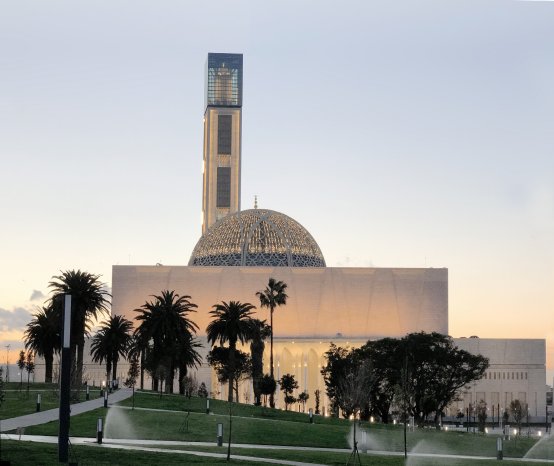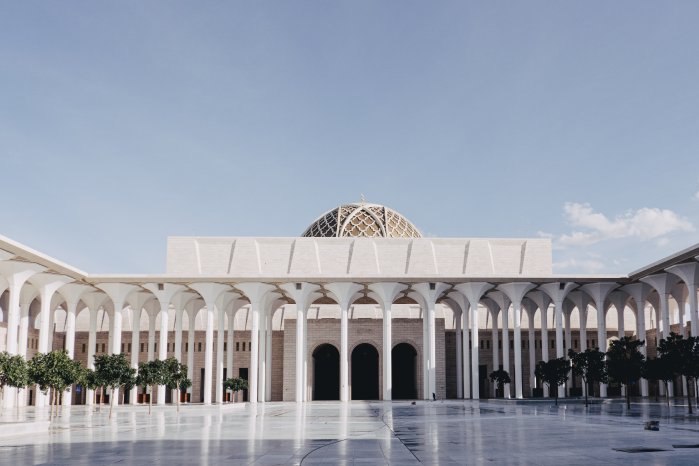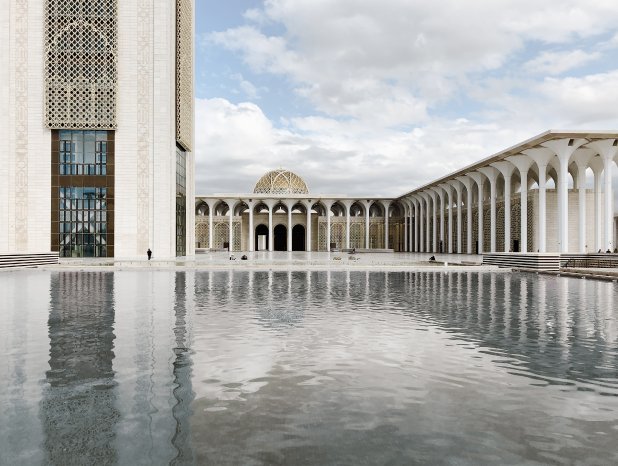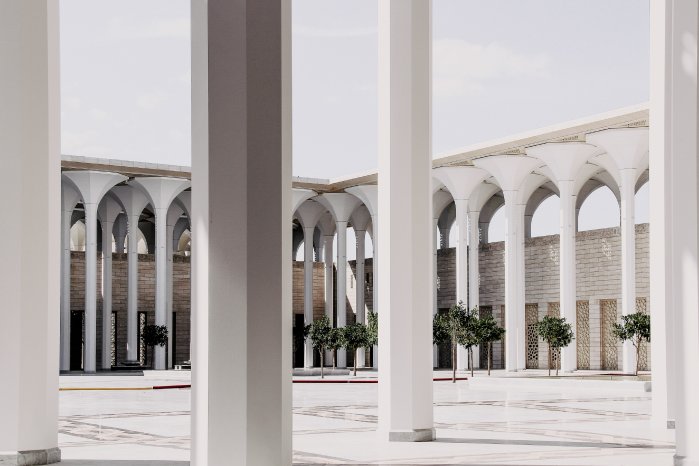The prize: “International Architecture Award” for landmark project in Algiers
Since 2004, the Chicago Athenaeum Museum of Architecture and Design together with the European Center for Architecture Art Design and Urban Studies as well as Metropolitan Arts Press, Ltd. has organized the “International Architecture Awards” to recognize the best and most significant new builds, landscape architecture and planning projects designed or constructed by the world’s leading urban and landscape planners worldwide. This year, the Grand Mosque of Algiers, which was designed by KSP Engel, is also among the prize winners.
The “Djamaâ el-Djazaïr”, Arabic for Mosque of Algeria, was completed in 2020 and publicly commissioned for use in the fall of last year. As the Friday Mosque, it is destined to accommodate about 120,000 visitors and is considered the world’s third largest mosque. Alongside the architecture by KSP Engel, the landscape planning by Rainer Schmidt Landschaftsarchitekten and the load-bearing structure by KREBS+KIEFER International also received due recognition.
The Mosque: a superlative joint work from three cultural circles
After the Islamic pilgrimage sites in Mecca and Medina, it is the third largest mosque in the world. At 265 meters tall, its minaret is higher than any other, while the Prayer Hall hosts up to 36,000 worshippers on religious festival days. The entire complex provides space for up to 120,000 visitors every day and, alongside the Prayer Hall and the minaret, comprises further facilities such as a museum with a research center for Islamic art and history, a conference center, a library, a theological college, apartments and infrastructure buildings.
The religious building in the Bay of Algiers is a joint project by architects, engineers and construction companies from three cultural worlds – Europe, North Africa and China – and the whole complex on the 26-hectare site was commissioned by the Algerian government. The mosque was designed by German planners: the consortium of KSP Engel and KREBS+KIEFER International; in 2008, the architectural design by KSP Engel won the international competition and subsequently the consortium was charged with the general planning of this large-scale project. German Chancellor Angela Merkel and the Algerian President at the time both attended the contract signing – the official launch of the planning work – back in July 2008. Realization of this major project covering a gross floor area (GFA) of around 400,000 square meters in total was entrusted to China’s biggest construction company, the “China State Construction Engineering Corporation, or CSCEC for short, which acted as general contractor. In early 2012, construction work began on the Djamaâ el-Djazaïr.
Through a series of major projects, Algeria’s government is aiming to make its country’s modernization and rejuvenation visible. The Grand Mosque is one such project, alongside universities, schools, infrastructure and transport facilities, including the new airport in Algiers.
“When we studied the site we immediately realized how important it was to reflect local conditions: the proximity of the sea, the strong sunlight, the line of mountain ridges that separates the Bay of Algiers from the hinterland and the desert. We choose this large shape in order to give the building a strong presence at its location between the sea and the mountains,” recalls Jürgen Engel, architect, on the approach taken at the beginning of the design and planning process.
The goal: a confident symbiosis of Maghreb building tradition and European Modernism
The design as realized not only scored points in the international architecture and general planning competition, but also provides an answer to the question of how a mosque should be built today. The architectural practice reinterpreted the structure of the pillar-hall mosque, which is widespread in the Maghreb. As a Friday mosque, the Grand Mosque is not only at the heart of religious activities, but is also a center of the community and society as a whole – hence, similarly to a town center, the complex also plays a secular, public function, incorporating shops, teahouses and a cinema with four screens. These venues lend vibrancy to the mosque complex as they are places where people can meet and spend time. An extensive park connects the 600-meter-long main complex with the neighboring conference center, the library and the theological college. With the Great Mosque, the garden was an essential component of the conception from the very beginning. The design originates in Germany, and is the work of the internationally active Munich office of Rainer Schmidt Landscape Architects and Urban Planners.
The main complex with its Prayer Hall is based on a clear structure with four square modules placed in a line, each measuring around 145 x 145 meters. They form a hierarchical spatial sequence in a linear arrangement; in the direction of Mecca, the open forecourt with the entrance arcades (the pergola) and the view of the sea is followed in the line by the (esplanade) that transitions to the religious areas like the main forecourt (cour) and the Prayer Hall (salle de prière). The joint podium houses an underground car park with approx. 4,000 parking spaces and as a raised platform creates a clear spatial division from the multilane expressway that runs parallel to the complex.
The inspiration: the flora of the continent and the culture of the country
The key stylistic element of the ensemble is the slender pillars with their projecting capitals, which can be found in all parts of the complex. Their form and proportions were inspired by the calla lily that is native to Africa. These floral pillars – 618 of them in total – are installed in various heights and versions depending on their functions and requirements, and they serve as a central connecting element of all areas of the ensemble. Indeed, the interior of the large Prayer Hall with its central dome is also divided up by pillars, which reach heights of up to 45 meters here. The pillars also serve for technical purposes such as ventilation, drainage from the roof surfaces and improvement of spatial acoustics thanks to their expansive capitals. The Mezquita-Catedral of Córdoba provided a historical reference here, with its tightly packed rows of pillars that divide up the Prayer Hall and yet still make the breadth of the space perceptible. The design of the complex is based on the way the architects engaged with local conditions: “The colors and materiality of the desert are expressed by the sand-colored natural stone (travertine). The opulent vegetation in Algeria is reflected in the floral pillars with their chalice-shaped ‘calla’ capitals as the element bracketing the entire complex,” is how Jürgen Engel explains his choice of materials and shapes.
The minaret: a modern hybrid high-rise with a viewing platform
Aside from the dome, which measures 50 meters in diameter and reaches a height of 70 meters at its apex, the major landmark of the complex and easily visible from afar is the minaret, which soars to 265 meters. It is not only currently the highest structure in Africa, but also the world’s tallest minaret, beating the Hassan II Mosque in Casablanca, Morocco. The slender tower follows the building tradition of the Maghreb: shifted asymmetrically from the axis with a square footprint. At the same time though, it is the first minaret in the world to take on various different functions and is therefore similar to a modern hybrid high-rise. Along with a viewing platform in the glazed top of the tower (the Sommah), the structure also includes a museum complete with a research center, office areas and sky lobbies. These likewise serve as viewpoints and break up the tower visually into five segments in line with the five pillars of Islam.
The particular challenge: earthquake protection unique on this scale
At 265 meters high, the minaret is located in an area of substantial seismic activity. In order to ensure the stability of this very slender tower with its small footprint of 28 by 28 meters, the engineers incorporated 50-meter-deep so-called “barette” foundations with 1.20-meter thick concrete walls. The load-bearing structure of the high-rise combines steel and concrete, which stand up to the loads created by earthquakes extremely well.
The earthquake stability of the Prayer Hall is achieved through its positioning on seismic isolators. These ensure that the structure is able to move in all directions in case of an earthquake and is thus largely detached from the shocks. The extraordinary dimensions of the structures, the stresses of the climate and earthquakes, and the local limitations of the construction technology and building materials were challenges that the architects and engineers had to overcome.
Short Story
1. The Grand Mosque of Algiers by KSP Engel wins the "International Architecture Award 2021".
2. This superlative project is a confident symbiosis of Maghreb building tradition and European Modernism.
3. The Friday mosque forms both the heart of religious matters and an urban center for society and social life.
4. The sacred building developed as a joint project by architects, engineers, and construction companies from three cultural circles: Europe, North Africa, and China.
5. The earthquake protection of the site as a whole, including the minaret as the highest building in Africa, is unique on this scale.
Project data
Developer: ANARGEMA: Agence Nationale de Réalisation de Gestion de la Mosqueé d’Algérie
Architect: Jürgen Engel, KSP ENGEL
General planning: KSP ENGEL together with KREBS+KIEFER International
GFA (total area): approx. 400.000 m²
Height of minaret: 265 m
Competition: 01/2008, 1st prize
Groundbreaking ceremony: October 31, 2011
Start of construction: early 2012
Commissioning: 2020
Opening of Prayer Hall: October 28, 2020 (festival of Mawlid an-Nabi, birth of the Islamic prophet Mohammed), November 6, 2020 prayer hall opened to the public for the first time for Friday prayers








